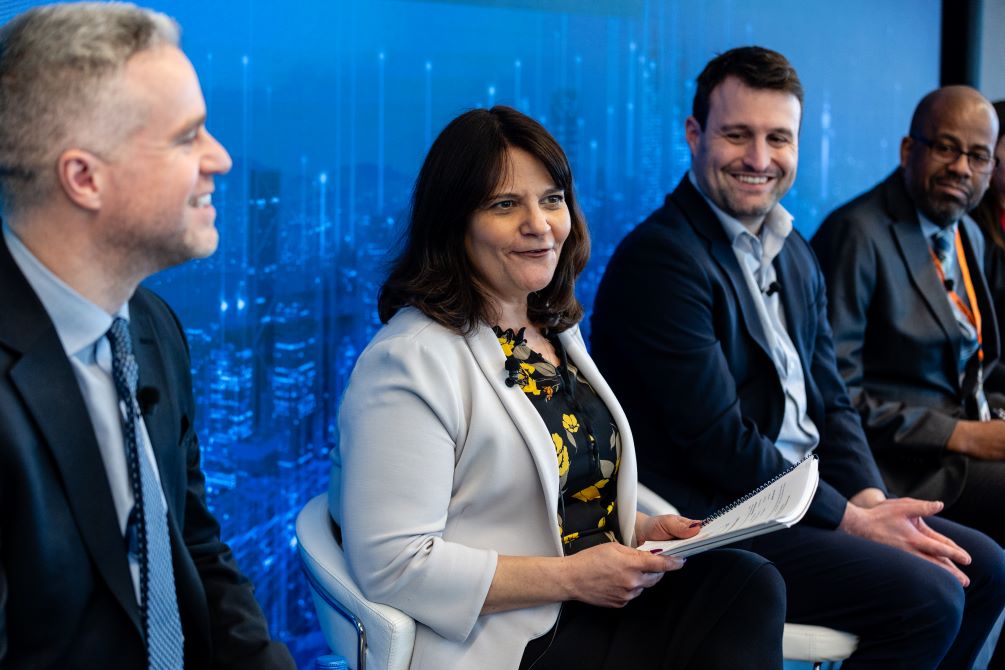At Sempra Energy, we deliver energy with purpose to over 35 million customers. There is a critical need to build a new global energy system by the middle of the century to advance the energy transition, which includes decarbonizing the industrial, power generation and transportation sectors.
Transportation is the backbone of the U.S. economy. Goods worth more than $13 trillion were transported by truck or rail in the U.S. in 2017. Unfortunately, in the U.S., transportation is responsible for nearly 30% of the country’s greenhouse gas emissions, more than any other economic sector.
If the U.S., as well as the world, is committed to lowering emissions, the transportation sector will be a vital component.
Electric and natural gas utilities are well-positioned to meet additional clean transportation infrastructure needs. Across the Sempra Energy family of companies, our utilities have a long history and strong track record of success supporting clean transportation.
SDG&E
Supporting Electric Vehicles, Piloting Vehicle-to-Grid Technology
Through its Power Your Drive charging program, San Diego Gas & Electric Company (SDG&E) has installed, owns and operates over 3,000 chargers at more than 250 workplaces and multi-unit dwellings. The utility is also installing 340 chargers at parks, beaches and schools and is building the infrastructure to support more than 3,000 fleet vehicles within its service territory. Electric Vehicle (EV) charging pilot programs with Amazon, UPS and the Port of San Diego are underway as well.
In addition to EV charging, SDG&E supports EV use by upgrading the electrical grid to meet increasing demand. The California Energy Commission projects that by 2025, 188,000 charging stations will be in use statewide. By 2030, there will be a need for 1.5 million.
Looking to new technologies, SDG&E sees the potential to further maximize EVs by using EV batteries as a source of energy. SDG&E’s Vehicle-to-Grid Integration Pilot Project includes the use of school buses to demonstrate how this could work. Buses will prioritize charging their on-board batteries when energy prices are low and renewable electricity is most available, for example from 10:00 a.m. to 2:00 p.m. Then, in the late afternoon and evening, as use of home and office air conditioning units increases, the buses will be able to discharge their energy, supporting system-wide resilience. SDG&E expects to scale up and deploy these types of innovations across its service territory.
Oncor
Preparing for EV Fleets
As the largest energy delivery company in Texas, Oncor is preparing to serve additional EVs, particularly in the fleet vehicle space.
The Texas market is particularly suited to expanded adoption of electric and electric-hybrid vehicles, especially vehicle fleets. In fact, according to the U.S. Department of Transportation, Bureau of Transportation Statistics, nearly 13% of total U.S. freight by weight moves through Texas, most of it through Oncor’s service area. This is about the same amount as the next two largest states combined.
Planning to meet this demand will be essential. There are roughly 22,000 fleets in Oncor’s service area. The company has fielded inquiries from major commercial, municipal, school and transit customers about joint planning for charging opportunities and logistics. Planning to support more than 4,000 EVs by 2022-2024 is already underway, dependent on the ability of equipment manufacturers to meet expected availability, range and total cost of ownership.
Serving commercial and industrial areas where tens of thousands of fleet vehicles will soon need electricity will likely require adding transmission assets, including higher-capacity electric lines, transformers and substations. Oncor has also developed the Green Fleet Growth Planning Tool, which identifies available substation and transformer capacity and predicts how population growth will impact that capacity through 2050.
SoCalGas
A Leader in Low, Zero, and Negative Carbon Fuels Like Compressed Natural Gas, Renewable Natural Gas and Hydrogen
Southern California Gas Company (SoCalGas) is the largest natural gas distribution utility in the U.S., serving nearly 22 million customers in California. It supports the transition away from petroleum and diesel fuel, to the use of cleaner transportation fuels across its service territory, including the use of renewable natural gas (RNG) and hydrogen.
Substantial gas-related transportation infrastructure is already in place, but additional infrastructure will be needed to support projected growth.
Natural Gas Vehicles
Based on the 2020 California Gas Report forecast, SoCalGas expects the natural gas vehicle (NGV) market to grow and add over 80 NGV stations and almost 4 billion cubic feet within its service territory over the next 15 years. SoCalGas will continue to invest in the additional pipeline capacity and NGV station service lines needed to meet this demand.
Renewable Natural Gas
Nearly 80% of the natural gas vehicles in California are already being fueled with RNG, a fuel that can have a negative carbon intensity. Supply of and demand for this fuel are increasing. A recent study by ICF4 7 estimates that by 2040, the Pacific region of the U.S. could produce between 193-372 billion cubic feet of RNG per year which would represent 66-126% of SoCalGas’ projected 2035 core natural gas consumption. As one example of increasing demand, SoCalGas currently has 15 NGV stations and is looking to add more to its system in 2021, all of which will be dispensing 100% RNG.
Hydrogen
Hydrogen is rapidly emerging as a clean transportation fuel. The California Energy Commission approved a plan in December 2020 that will invest up to $115 million to significantly increase the number of hydrogen fueling stations in the state, nearly doubling the state’s investments to date and will help California nearly achieve its goal to deploy 200 public hydrogen fueling stations.
Transit agencies in particular, including Orange County Transit Authority, Foothill Transit and Sunline, have indicated that they expect to transition to hydrogen. In addition, SoCalGas has completed preliminary site evaluations for two major energy companies in response to their interest in hydrogen fueling stations.
SoCalGas recently announced plans to field test a new technology that can simultaneously separate and compress hydrogen from a blend of hydrogen and natural gas. At scale, this would allow hydrogen to be transported easily and affordably via the natural gas pipeline system, then extracted and compressed at fueling stations that provide hydrogen for fuel cell electric vehicles.
Thanks to the forward-thinking teams across our family of companies, Sempra Energy is helping decarbonize the transportation sector and advance clean energy infrastructure across the U.S.









